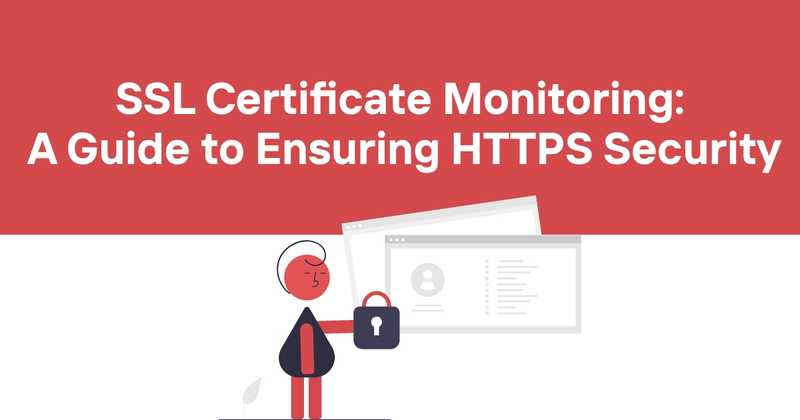SSL Certificate Monitoring: A Developer's Guide to Ensuring HTTPS Security
Table of Contents
- Introduction
- Understanding SSL Certificates
- The Importance of SSL Certificate Monitoring
- Common SSL Certificate Monitoring Challenges
- Effective SSL Certificate Monitoring Strategies
- Best Practices for SSL Certificate Management
- Implementing SSL Certificate Monitoring in Your Development Workflow
- Handling SSL Certificate Renewals
- Troubleshooting Common SSL Certificate Issues
- Future Trends in SSL Certificate Management
- Conclusion
Introduction
SSL certificates play a very important role in ensuring that communication via the internet remains secure and builds trust in users. Being a developer, it is considered paramount to ensure these certificates are valid and renewed well in time to avoid any service disruptions and security vulnerabilities. It pinpoints the nuances of monitoring SSL certificate expiration and equips you with practical strategies and insights into how best to address this vital concern in web security.
Understanding SSL Certificates
Basically, SSLs, now more correctly referred to as TLS certificates, are documents in digital form that authenticate the identity of a website over the network and establish encrypted connections. These are issued through Certificate Authorities, or CAs, and usually have a validity period from some months to a few years.
Key components of an SSL certificate include:
- Domain name
- Certificate Authority information
- Issue date
- Expiration date
- Public key
- Digital signature
Understanding these elements is crucial for effective monitoring and management of SSL certificates.
The Importance of SSL Certificate Monitoring
Monitoring SSL certificates is not just a best practice; it's a necessity for maintaining a secure and reliable web presence. Here's why it's so important:
-
Preventing Service Interruptions: Expired certificates can cause browsers to display warning messages or block access to your website, leading to a poor user experience and potential loss of traffic or revenue.
-
Maintaining Security: Valid SSL certificates ensure that data transmitted between your server and users remains encrypted and secure from potential eavesdropping or tampering.
-
Preserving User Trust: Websites with valid SSL certificates inspire confidence in users, particularly important for e-commerce and sites handling sensitive information.
-
Compliance Requirements: Many industries have regulatory requirements mandating the use of valid SSL certificates for data protection and privacy.
-
SEO Benefits: Search engines like Google give preference to secure websites in their rankings, making valid SSL certificates a factor in your site's visibility.
Common SSL Certificate Monitoring Challenges
Despite its importance, SSL certificate monitoring comes with several challenges:
-
Multiple Certificates: Large organizations often manage numerous certificates across different domains and subdomains, making tracking a complex task.
-
Decentralized Management: In some organizations, different teams or departments may be responsible for different certificates, leading to inconsistent monitoring practices.
-
Short Validity Periods: The trend towards shorter certificate lifespans (e.g., 90 days for Let's Encrypt certificates) increases the frequency of required renewals.
-
Certificate Chain Issues: Problems with intermediate or root certificates in the certificate chain can be overlooked if only focusing on the end-entity certificate.
-
Wildcard and Multi-Domain Certificates: These types of certificates can cover multiple subdomains or domains, potentially obscuring which specific services might be affected by expiration.
-
Cloud and Third-Party Services: Certificates used by cloud services or third-party providers may not be directly under your control but can still affect your applications.
Effective SSL Certificate Monitoring Strategies
To overcome these challenges, consider implementing a combination of the following strategies:
Manual Tracking Methods
While not ideal for large-scale operations, manual tracking can be effective for smaller setups:
-
Spreadsheet Tracking: Maintain a spreadsheet with certificate details, including domain, expiration date, and renewal instructions.
-
Calendar Reminders: Set up calendar events with alerts for upcoming expirations.
-
Regular Manual Checks: Periodically review certificate details using browser tools or command-line utilities like OpenSSL.
Automated Monitoring Solutions
For more robust and scalable monitoring, consider automated solutions:
-
Custom Scripts: Develop scripts using languages like Python or PowerShell to check certificate expiration dates and send alerts.
-
Monitoring Tools: Utilize existing monitoring platforms that offer SSL certificate checks as part of their feature set.
-
Certificate Management Platforms: Implement dedicated certificate lifecycle management tools that offer comprehensive monitoring and renewal capabilities.
Third-Party Certificate Monitoring Services
Several services specialize in SSL certificate monitoring:
-
SSL Certificate Monitoring Services: These services continuously check your certificates and provide alerts via email, SMS, or API integrations.
-
Certificate Authority Services: Many CAs offer monitoring and auto-renewal services for certificates issued through them.
-
Web Application Firewalls (WAFs): Some WAF solutions include SSL certificate monitoring as part of their security features.
Best Practices for SSL Certificate Management
To ensure effective SSL certificate monitoring and management:
-
Centralize Certificate Inventory: Maintain a centralized repository of all SSL certificates used across your organization.
-
Implement Automated Monitoring: Use automated tools to continuously check certificate status and receive timely alerts.
-
Set Up Graduated Alerts: Configure alerts at different intervals (e.g., 90, 60, 30, 15, 7 days before expiration) to allow ample time for renewal.
-
Document Renewal Processes: Create clear documentation for certificate renewal procedures, including responsible parties and necessary steps.
-
Use Longer Validity Periods: Where possible, opt for certificates with longer validity periods to reduce the frequency of renewals.
-
Consider Auto-Renewal: Implement auto-renewal for certificates where feasible, ensuring continuous coverage.
-
Monitor the Entire Certificate Chain: Check not just the end-entity certificate but also intermediate and root certificates.
-
Implement Certificate Pinning: For critical applications, use certificate pinning to detect unexpected certificate changes.
-
Regular Audits: Conduct periodic audits of your SSL certificate inventory to ensure all are accounted for and properly monitored.
-
Stay Informed: Keep up-to-date with changes in SSL/TLS standards and best practices to maintain optimal security.
Implementing SSL Certificate Monitoring in Your Development Workflow
Integrating SSL certificate monitoring into your development process can help catch issues early and ensure consistent security practices:
-
Development Environment Certificates: Use self-signed or development CA certificates in non-production environments, but ensure they are also monitored.
-
CI/CD Integration: Incorporate certificate checks into your Continuous Integration/Continuous Deployment pipelines.
-
Code Review Processes: Include certificate management considerations in code review checklists.
-
Testing Procedures: Develop and run tests that verify correct certificate implementation and handling in your applications.
-
Documentation: Maintain up-to-date documentation on certificate usage and monitoring procedures for all projects.
-
Training: Ensure all team members understand the importance of SSL certificate management and are familiar with monitoring processes.
Handling SSL Certificate Renewals
Effective renewal processes are crucial for maintaining uninterrupted SSL protection:
-
Plan Ahead: Start the renewal process well before the expiration date to account for any potential delays.
-
Verify Certificate Details: Double-check all certificate details during renewal to ensure accuracy.
-
Test Before Deployment: Always test renewed certificates in a staging environment before deploying to production.
-
Update All Instances: Ensure the renewed certificate is updated across all relevant servers and services.
-
Revoke Old Certificates: Properly revoke the old certificate after successfully deploying the new one.
-
Update Monitoring Systems: Adjust your monitoring tools to track the new certificate's details.
-
Document the Process: Keep a record of each renewal, including any issues encountered and their resolutions.
Troubleshooting Common SSL Certificate Issues
Even with careful monitoring, issues can arise. Here's how to address common problems:
-
Certificate Not Trusted: Verify the entire certificate chain and ensure all intermediate certificates are properly installed.
-
Name Mismatch: Confirm that the certificate's Common Name (CN) or Subject Alternative Name (SAN) matches the domain exactly.
-
Expired Certificate: Immediately renew the certificate and update it on all relevant servers.
-
Revoked Certificate: Investigate the reason for revocation and obtain a new certificate if necessary.
-
Weak Cipher Suites: Update server configurations to use strong, modern cipher suites.
-
Mixed Content Warnings: Identify and update any HTTP resources loaded on HTTPS pages.
-
Certificate Pinning Issues: Update the pinned certificate information in your application code.
| Issue | Symptoms | Resolution |
|---|---|---|
| Expired Certificate | Browser warnings, connection failures | Immediate renewal and deployment of new certificate |
| Name Mismatch | SSL errors, security warnings | Reissue certificate with correct domain name(s) |
| Incomplete Chain | Connection issues on some clients | Install full certificate chain including intermediates |
| Revoked Certificate | Unexpected certificate warnings | Investigate revocation reason, reissue if necessary |
| Weak Cipher Suite | Security scan warnings | Update server configuration to use strong ciphers |
Future Trends in SSL Certificate Management
As the digital landscape evolves, so do SSL certificate management practices:
-
Shorter Certificate Lifespans: The trend towards shorter validity periods is likely to continue, increasing the importance of efficient monitoring and renewal processes.
-
Automation and AI: Expect more sophisticated automation tools, possibly incorporating AI for predictive maintenance and issue detection.
-
Blockchain-Based Certificates: Exploration of blockchain technology for more secure and transparent certificate issuance and validation.
-
Post-Quantum Cryptography: As quantum computing advances, certificate authorities and browsers will need to adapt to quantum-resistant algorithms.
-
IoT Device Certificates: The growth of IoT will drive new solutions for managing certificates across vast numbers of devices.
-
Enhanced Validation Methods: Expect more stringent and potentially automated methods for validating domain ownership and organization identity.
Conclusion
This makes effective SSL certificate expiration monitoring a very vital ingredient in web presence security and reliability. At the end of the day, strong monitoring strategies, adherence to best practices, and keeping up with emerging trends will all combine to make for developers who can protect their applications and ensure they remain trusted. Remember, SSL certificate management is a process-one that requires vigilance-though it is certainly worth the effort, as it affords peace of mind and security.



